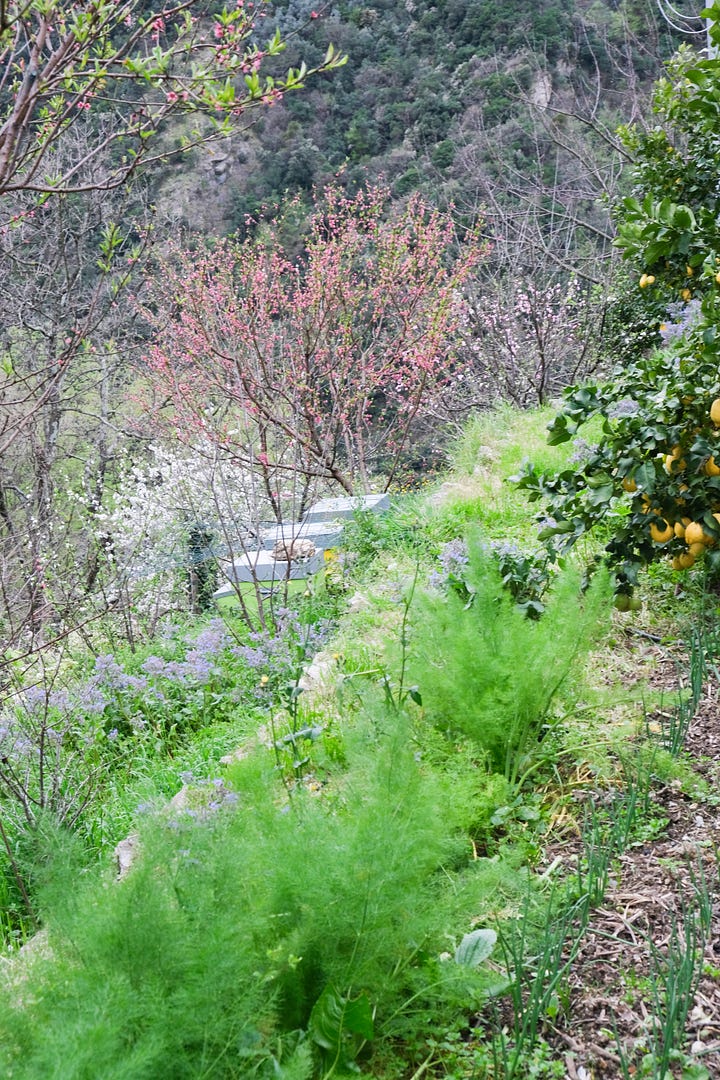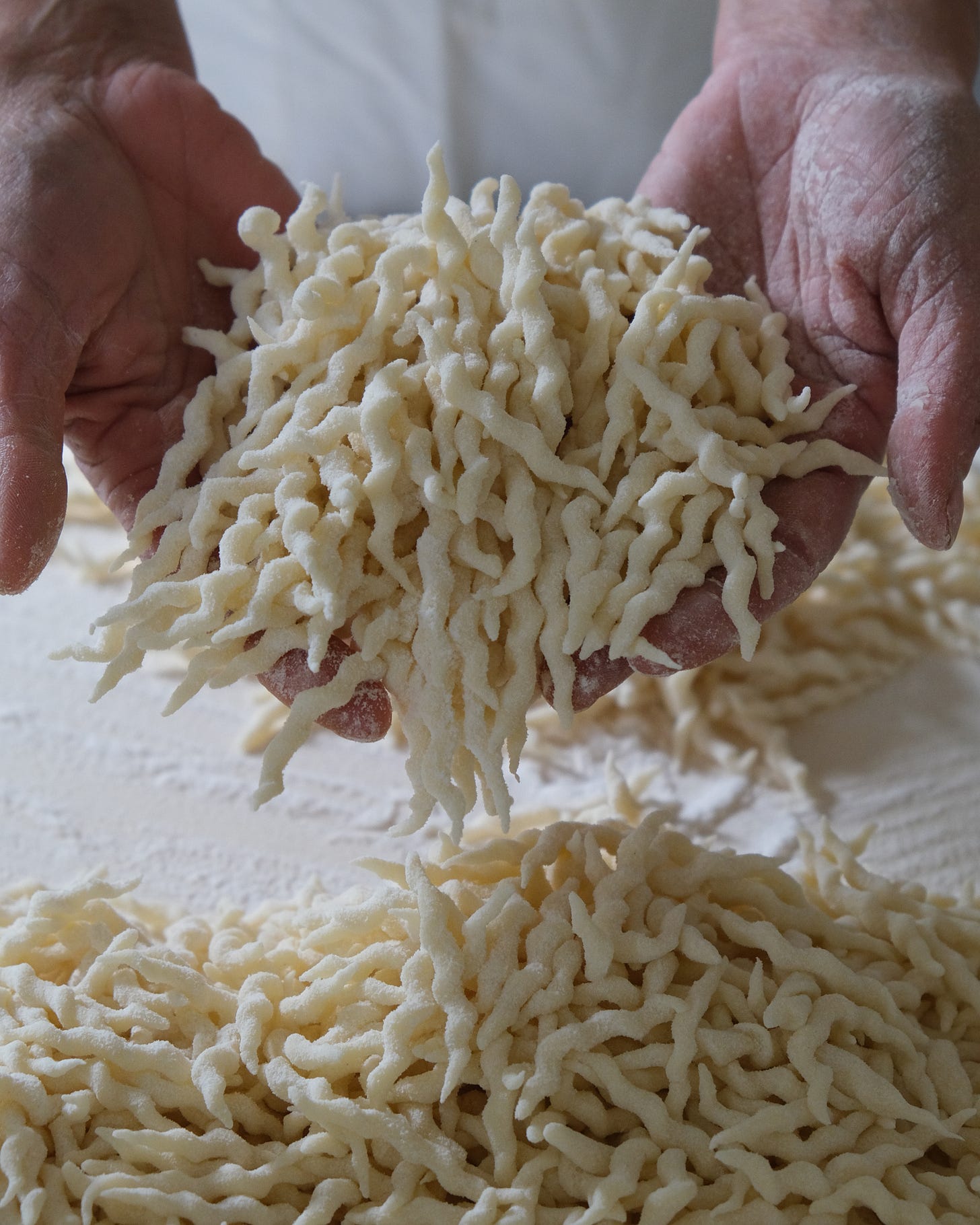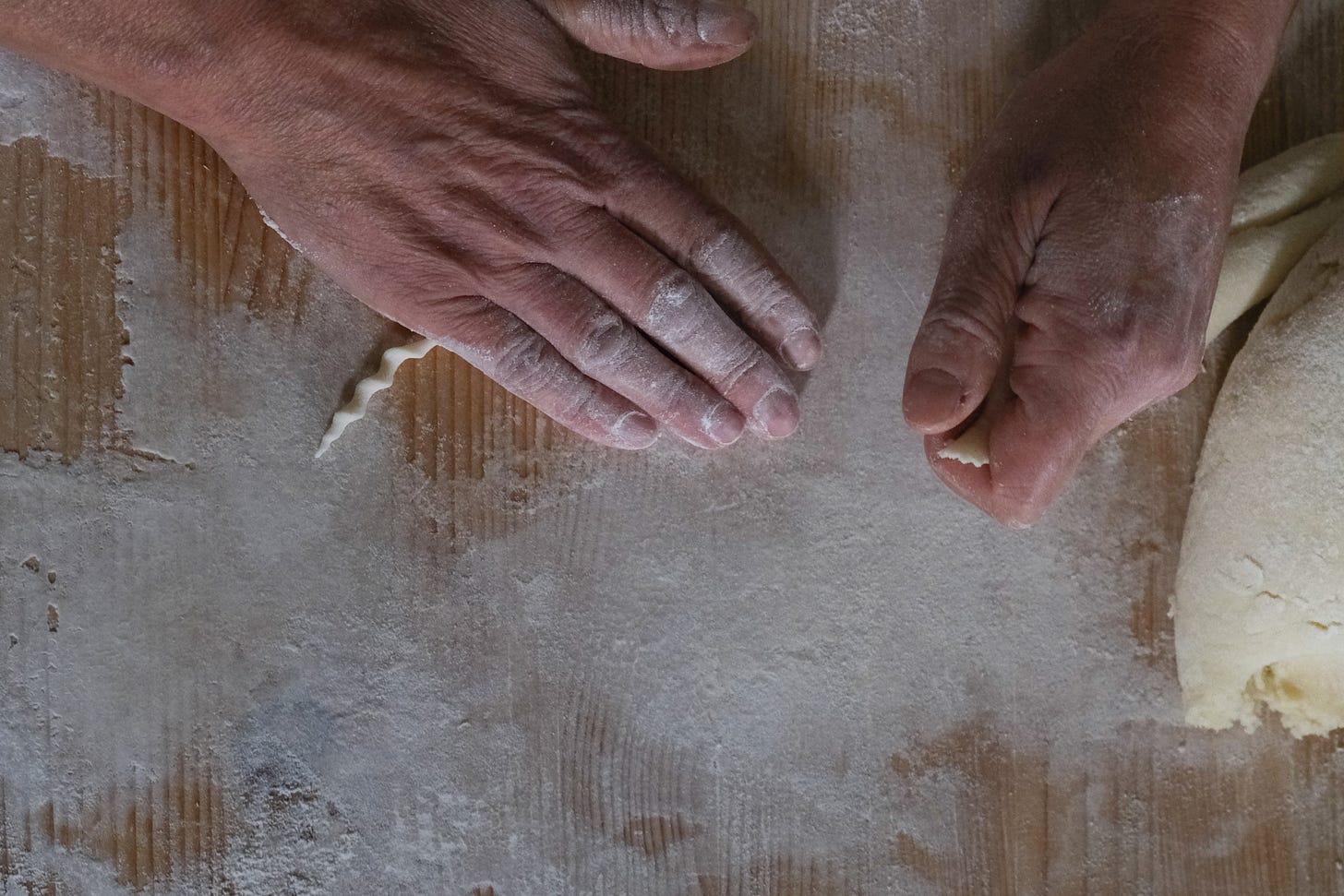At the roots of trofie, the Ligurian iconic pasta
When in Testana, on the hills behind Recco, I met Sandra who grew up shaping trofie with her nonna + A parsley pesto recipe and an unplanned move for my Genoa Foodie Guide.
I believe stories like this deserve to be told—and shared.
Let’s keep our food heritage alive, together ❤️.
It was a bright spring morning when my friends Alessandra, Ambra and I drove up to Testana, a handful of houses nestled in the hills behind Recco. That’s where we met Sandra, in her little home pasta workshop surrounded by the first signs of spring, olive groves, and lemon trees. As she welcomed us with a warm smile, she began sharing her story—one shaped by generations of women, flour, and tradition.


Sandra grew up making trofie. She has no memory of learning—the motion of rolling and twisting the dough was simply something she always knew how to do, also probably thanks to the little keadingboard her nonna gave her when she was 3 years old. In the 1970s, many families owned a small pasta workshop. “There were five or six in the village,” she told us. “We made tons of trofie back then.”
Her grandmother too ran this small family pasta business for decades. Sandra’s mother and great-aunts—four or five women at a time—would gather around the wooden table and shape trofie for hours, chatting as they worked.
“We started after lunch and went on until evening. We chat, share our life and sometimes just stay silent, each-one lost in her thoughts”
In a single day, they could produce up to 20 kilos of pasta. Sandra remembers those mornings when she didn’t have to go to school and with her grandfather they load the car with trays full of trofie and deliver them to pasta shops and restaurants in the nearby towns on the coast like Recco, Bogliasco and Nervi. “I loved those mornings spent with my grandad in the Riviera”, she said dreamingly.
Sandra’s nonna stopped making trofie in the early 2000’s.
It was a women’s affair— a meticulous, collaborative, and deeply skilled work. This small, all-female micro-economy was vital to many Testana households, helping supplement the men’s wages with what they could earn by the kilo.
Back then, they used basic white flour—whatever was available. Today, Sandra uses granito, a soft wheat flour ground with its germ still intact, rich in flavor and coarser in texture. It looks almost like semolina but is made from soft wheat. “It’s not widely used anymore,” she explained, “because it leaves a lot of waste in milling. But it’s worth it.”


Of course we asked for the recipe: 600 grams of “granito” flour and 450 grams of boiling water, kneaded quickly while hot. She rolls the pasta on a rough wooden board (madia), just like her grandmother did—the texture helps create the signature twist. Then she dusts the just made trofie with rice flour to prevent them from sticking to each other.
Watching Sandra make trofie was almost hypnotic: those quick confident gestures and the deep silence broken only by a soft, sliding rhythm as the dough moved under her fingers.
Want to feel the magic yourself? Watch the video below and let Sandra’s hands do the talking.
If you want to savor the full interview with Sandra (with English subtitles) watch this video on my Youtube channel.
But there is more…
Sandra tells us that in winter, chestnut trofie made their appearance, as the local freshly milled chestnut flour became available. Sandra still makes them with a careful mix of chestnut flour and granito. Too much chestnut flour, and the dough becomes brittle. It took her a while to find the right balance: enough to give flavor, not so much that it breaks.
And while today we think of basil pesto as the only natural companion for trofie, Sandra told us about a winter version of pesto they used in Testana when basil (back then just a summer fresh herb) wasn’t available. It was a parsley pesto, made with (surprisingly) boiled parsley, borage, and young chard leaves, pounded in a mortar with a few pine nuts, a touch of garlic, grated Parmigiano, olive oil, and a little pasta water to bind it all together. A delicate, herbaceous sauce that tells of seasonality and adaptation.
This rustic green pesto wasn’t the only winter condiment. In the inland village of Gattorna, chestnut trofie were often served with salsa agliata: a rich sauce of garlic, pine nuts, and cream.
Sandra reopened her own little workshop a couple of years ago. She now prepares handmade trofie for a few restaurants in the area who still care about offering artisanal pasta. She also makes them for private events. With her practiced hands and a wooden board passed down from her grandmother, she keeps alive not just a recipe, but a way of life.
Here below you find the recipe for parsley pesto—Sandra’s winter green sauce that captures the soul of the Ligurian hills in colder months (but you can give it a try also now and with any kind of pasta!).It’s a velvety, earthy pesto that wraps around pasta like a wool shawl and most important delicious! I made it just back home from visiting Sandra (and with herbs directly picked in her wonderful terraced garden).


PARSLEY PESTO
Ingredients
(Makes enough for 4 servings of pasta)
1 packed cup (ab 40 grams) flat-leaf parsley, roughly chopped
½ cup (ab 30 grams) young borage leaves, cleaned and stemmed
½ cup (ab 15 grams) baby Swiss chard (or tender beet greens)
1 small garlic clove (optional)
2 tablespoons pine nuts
⅓ cup extra virgin olive oil, preferably Ligurian
¼ cup Parmigiano Reggiano, finely grated
1–2 tablespoons fresh cream (optional, for softness)
Salt, to taste
A few tablespoons of pasta cooking water, to loosen if needed
Instructions
Blanch the greens: bring a small pot of salted water to a simmer. Add parsley, borage, and chard, and cook for 2–3 minutes, just until softened. Drain well and gently press out excess water — they should be moist, not soggy.
In the mortar: if using a mortar and pestle, crush the garlic (if using) with the pine nuts. Add the blanched greens a little at a time, pounding until you get a creamy texture. Fold in the grated cheese and mix gently. Add the olive oil and mix gently. Adjust salt.
In the food processor: combine the blanched greens, pine nuts, garlic, and a pinch of salt. Stir in the cheese and mix. Add the extra virgin olive oil and mix by hand at the end. If you like, add a spoonful of fresh cream to round out the flavor.
Adjust the texture with a few spoonfuls of warm pasta water right before tossing with your pasta. This pesto is especially good with chestnut flour trofie but also with handmade gnocchi or any kind of pasta, actually!
A small adjournment: I had to move my Genoa foodie guide…
As you might remember from one of my recent newsletters, this winter I worked on a digital, interactive, mobile-friendly Genoa Foodie Guide — created to help fellow food lovers visiting Genova track down the best bites in town.
I launched the guide on March 6 via Thatch.com, a travel guide platform. Then, just five days later (yes, five!), I got an email from Thatch announcing they’d be shutting down by the end of March. They’d stop selling travel guides and merge with an AI-powered travel planner platform.
So, a heartfelt thank you to Thatch.com for:
Leaving my guide homeless a mere five days after it was born;
Contributing to the booming market of AI-generated (read: unverified, cliché-filled, mildly weird) travel advice — which now competes with me: a real human, a local travel consultant, and someone who actually knows and loves this quirky little corner of the world.
(It’s a hot topic I’ll probably rant about in depth one day. For now, I’m still too annoyed.)
But let’s not panic. If you’ve already purchased the guide — first of all, grazie di cuore — you wll still be able to access it. Thatch have already sent you directions via e-mail on how to continue to see it on the merging travel platform.
Then, luckily enough, I quickly found a new cozy home for my Genoa Food Guide!
It's now hosted on SALTETE, a travel guide publishing platform founded by Regan Stephens — a travel and food journalist (yes, an actual human being — remember those?).
The guide itself? Still the same delicious content, with all the features you loved:
🗺️ A live, interactive map that shows you exactly where you are — no more wandering aimlessly or playing “guess the alley.” (Just make sure you allow location access in your browser.)
📱 Mobile-friendly design, so it’s always in your pocket, ready to save your stomach.
✨ Just a new look. Same spirit.
Scroll down to check out the new version — and if you haven’t explored it yet, this might be the perfect excuse to treat yourself (or your tastebuds).
As a thank-you for sticking around, you can still get 15% off with the code TASTEOFLIGURIA — that’s at least one extra gelato while you’re in town 😊.
Have a good week end and…make trofie!
Enrica






Hello, Enrica! I thought of our wonderful cooking class from last October today! I wondered what local Spring dishes you were making and then read this post. Thank you for reminding me of the beauty and peace in making traditional local foods. Happy Spring! Barbara Wilson
Hi - what if I can’t find borage ?